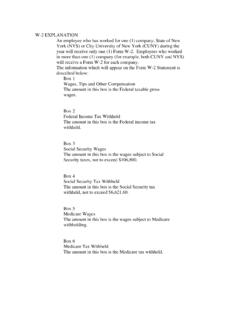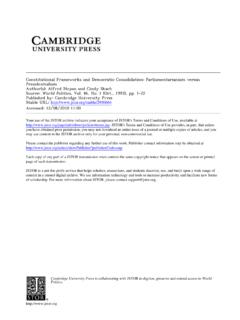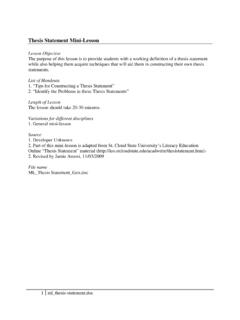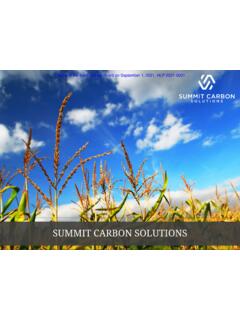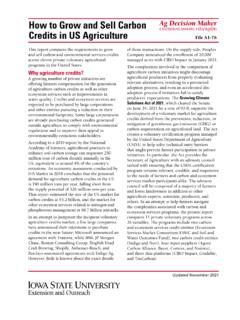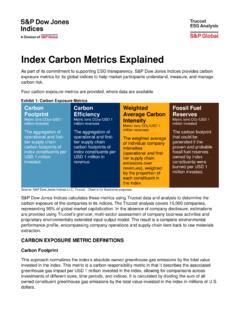Transcription of Title: THE CARBON CYCLE - Brooklyn College
1 title : THE CARBON CYCLE Grade and Subject: 8th-12th grades Number of Days for Completion of the Project: Overarching Project Goals/Outcomes: Getting background knowledge for a scientific investigation. Students will be provided with a glossary page containing the definitions for the various components of the CARBON CYCLE along with a diagram of the CARBON CYCLE with blanks for fill in. Students will use their glossary along with their deductive reasoning to complete the CARBON CYCLE handout. Materials: CARBON CYCLE Glossary CARBON CYCLE Fill-in Handout Introduction: Discussion on what is the CARBON CYCLE and the importance of background investigation and understanding within a scientific investigation.
2 Instruction/Direct Experience: 1. Students will gain an understanding of the different components of the CARBON CYCLE . Independent Activities: Students will work in pairs completing the CARBON CYCLE . Assessment: Student s ability to work in teams as well as use the materials provided to understand the different parts of the CARBON CYCLE . Follow-up This short lesson plan provides students with a preliminary understanding of the CARBON CYCLE , which will greatly aid in their larger investigation regarding CARBON dioxide compensation . Discussion notes in preparation for pre-excavation survey Discussion will begin with PPT on what an archaeologist does! - What can potentially be found? -Newspapers they have dates!
3 !! -Bottle Caps -Food wrappers (with or without expiration dates) IT S NOT JUST GARBAGE WHAT ABOUT NATURAL REMAINS FROM HUMAN ACTIVITIES?! -Charcoal -Fire pit -A pile of leaves (children playing or someone cleaning up an area) -Animal bones (chicken bones) could indicate a meal that had been consumed - What can different types of finds tell us about the people who left them? -The dates of the event (or a general timeline). -Over how long did the deposition take place (one season, one year, multiple seasons/years). -What activities were the space being used? -What was the diet of the users of the space? -Did people cook? - How do we record our findings? (maps, graphs, tables, etc.)
4 - What is important in designing a map? THE CARBON CYCLE _1_ Root respiration _2_ Organic CARBON _3_ Sunlight _4_ Auto and factory emissions _5_ Animal respiration _6_ Decay organisms _7_ Ocean Uptake _8_ Plant respiration _9_ Fossils and fossil fuels _10_ Organic CARBON _11_ Photosynthesis Image from: FOSSIL FUELS: Occasionally conditions do not allow organic matter to decompose properly, and if this matter becomes trapped in rocks then it can become fossil fuel. Such conditions prevailed many millions of years ago in the swamps which surrounded the trees of extensive tropical rainforests. Huge amounts of fossil fuel were laid down and remained untouched until they were discovered at the beginning of the industrial revolution.
5 Fossil fuels include coal, oil, and gas ( CARBON CYCLE Animation. West Virginia University. < /demo/Module_2 >.) PHOTOSYNTHESIS: Plants absorb CARBON dioxide gas from the atmosphere and use energy from the sun to convert it into simple sugars. This is how plants seem to grow from nothing, and why they don t survive long if they are kept in a dark place!!!!! ( CARBON CYCLE Animation. West Virginia University. <http://elearn. >.) PLANT & ANIMAL RESPIRATION: When we burn any substance there is a release of energy. In most cases this is heat energy. However, when plants and animals burn substances which they stored or ate, they are able to capture the energy to do useful things such as moving ( CARBON CYCLE Animation.)
6 West Virginia University. < >.) SOIL RESPRIATION/DECOMPOSITION: A huge community of organisms which specialize in decomposing dead organic matter reside in the Decomposers break down organic matter to release energy and CARBON dioxide which is released to the atmosphere ( CARBON CYCLE Animation. West Virginia University. < >.) BURNING/AUTO & FACTORY EMISSIONS: Whenever we burn a substance which contains CARBON , we release CARBON dioxide to the atmosphere. Since the industrial revolution we have been burning vary large quantities of fossil fuels such as coal, oil, and gas to provide energy for running our industries and modern lifestyles ( CARBON CYCLE Animation. West Virginia University.
7 < /demo/Module_2 >.) OCEAN UPTAKE: There is a huge amount of CARBON dioxide dissolved in the oceans. This is because CARBON dioxide dissolves so easily in water. In the surface waters tiny free-floating plants convert the dissolved CARBON into simple sugars using sunlight to drive photosynthesis. The free floating organisms in the ocean are known as plankton ( CARBON CYCLE Animation. West Virginia University. < >.) DEAD ORGANISMS & WASTE PRODUCTS/LITTERFALL: This flow represents the incorporation of dead organic matter into the It includes the movement of any dead organic matter to the soil, including fallen leaves, an apple core, a dead fly, or a discarded paper bag ( CARBON CYCLE Animation.
8 West Virginia University. < /Module_2 >.)

